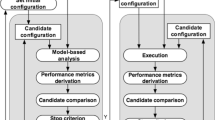Abstract
To rapidly explore the design space of a real-time embedded system, it is essential to be able to efficiently analyze the timing behaviors of different system architectures. This includes not only determining if a design can satisfy all the timing constraints but also comparing the timing performance of different designs for tradeoff purposes. Understanding the exact timing behavior of a large system can be computationally prohibitive. Previous work in this area has mostly focused on producing a yes/no answer to the schedulability of a system architecture under the worst-case scenario. This not only often leads to overly pessimistic designs, but also provides no insight as how to rank different architectural designs with respect to their timing performance. In this paper, we present several metrics that may be used to measure the timing performance of a design. The metrics were analyzed using workloads from both real-world task systems and randomly generated task systems. A superior metric has been identified through analysis of large sets of experiments. We also show, through an example, how this metric can be used effectively during a design exploration process.
Similar content being viewed by others
References
Audsley, N., Burns, A., Richardson, M., Tindell, K., and Wellings, A. J. 1993. Applying new scheduling theory to static priority pre-emptive scheduling. Software Engineering Journal 8(5): 284–292.
Balarin, F., and Sangiovanni-Vincentelli, A. 1997. Schedule validation for embedded reactive real-time systems. Proceedings of Design Automation Conference pp. 52–57.
Blickle, T., Teich, J., and Thiele, L. 1998. System-level synthesis using evolution algorithms. Journal of Design Automation for Embedded Systems 3: 23–58.
Devore, J. L. 1987. Probability and Statistics for Engineering and the Sciences. Monterey, California: Brooks/Cole Publishing Company.
Dick, R. P., and Jha, N. K. 1997. MOGAC: A multiobjective genetic algorithm for the co-synthesis of hardware-software embedded systems. 1997 IEEE/ACM International Conference on Computer-Aided Design pp. 522–529.
Gajski, D. D., Vahid, F., Narayan, S., and Gong, J. 1994. Specification and Design of Embedded Systems Englewood Cliffs, NJ: Prentice Hall.
Gupta, R. K., and De Micheli, G. 1993. Hardware-software cosynthesis for digital systems. IEEE Design & Test of Computers 10(3): 29–40.
Halang, W. A., and Stoyenko, A. D. 1994. Next generation of real-time operating systems: industrial perspective. Proceedings of the NATO Advanced Study Institute on Real Time Computing pp. 595–596.
Hu, X., D'Ambrosio, J. G., Murray, B. T., and Tang, D. 1994. Codesign of Architectures for Automotive Powertrain Modules. IEEE Micro pp. 17–25.
Hu, X., and D'Ambrosio, J. G. 1997. Hardware/software partitioning for real-time embedded systems. Journal of Design Automation for Embedded Systems 2(3/4): 339–358.
Hu, X., Greenwood, G. W., and D'Ambrosio, J. G. 1996. An evolutionary approach to configuration-level hardware/software partitioning. Proceedings of the 4th International Conference on Parallel Problem Solving From Nature pp. 900–909.
Lawler, E. L., and Martel, C. U. 1981. Scheduling periodically occurring tasks on multiple processors. Information Processing Letters 12(1): 9–12.
Lehoczky, J., Sha, L., and Ding, Y. 1989. The rate monotonic scheduling algorithm: Exact characterization and average case behavior. Proceedings of the 1989 IEEE Real-time System Symposium pp. 166–171.
Leung, J. Y-T. 1989. A new algorithm for scheduling periodic, real-time tasks. Algorithmica 4: 209–219.
Liu, C. L., and Layland, J. W. 1973. Scheduling algorithms for multiprogramming in a hard real-time environment. Journal of the ACM 20(1): 46–61.
Ramamritham, K., and Stankovic, J. A. 1984. Dynamic task scheduling in distributed real-time systems. IEEE Software 1(3): 65–75.
Sha, L., Rajkumar, R., and Lehoczky, J. P. 1990. Priority inheritance protocols: An approach to real-time synchronization. IEEE Transactions on Computers 39(9) 1175–1185.
Yen, T.-Y., and Wolf, W. 1995. Performance estimation for real-time distributed embedded systems. Proceedings of the International Conference on Computer Design (ICCD'95) pp. 64–69.
Wolf, W. 1994. Hardware-software co-design of embedded systems. Proceedings of the IEEE 82(7): 967–989.
Author information
Authors and Affiliations
Rights and permissions
About this article
Cite this article
Hu, X.(., Sambandam, R.S. Multi-Valued Performance Metrics for Real-Time Embedded Systems. Design Automation for Embedded Systems 5, 5–28 (2000). https://doi.org/10.1023/A:1008993532472
Issue Date:
DOI: https://doi.org/10.1023/A:1008993532472




